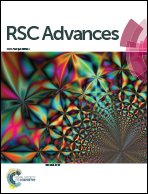Facile construction of graphene-like Ni3S2 nanosheets through the hydrothermally assisted sulfurization of nickel foam and their application as self-supported electrodes for supercapacitors†
Abstract
A facile and low-cost approach has been developed for the fabrication of large-area nickel sulfide nanosheets via the hydrothermally assisted sulfurization of Ni foam. The obtained Ni3S2 nanosheets exhibit perfect supercapacitor performance, retaining almost 93.6% of the maximum capacitance after 3000 cycles. The strategy of self-sulfurization is promising for use in the construction of other nanoarchitectured sulfide (e.g., CuS, FeS and SnS) arrays for electrochemical applications.


 Please wait while we load your content...
Please wait while we load your content...